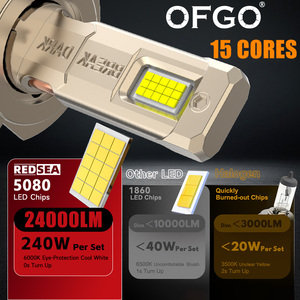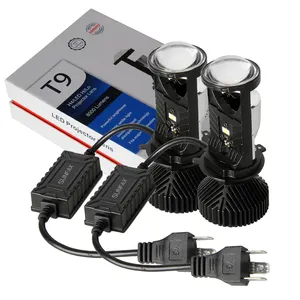
All categories
Featured selections
Trade Assurance
Buyer Central
Help Center
Get the app
Become a supplier

(8160 products available)














































Faro led lights have different types to suit various applications. They include the following:
Reflector type LED lights
Reflector type LED lights have a reflector that is shaped like a dish. The reflector's design directs light onto the road without creating a glare. These lights are common in car models that need to look classy and elegant.
Projector type LED lights
Projector type LED lights use special lenses to focus the light into a beam. As a result, these lights provide a more intense and precise light compared to reflector-type lights. They are commonly used as LED fog lights and in car models that need advanced lighting.
Composite LED lights
Composite LED lights combine both reflectors and projectors along with different colored LEDs. This type of LED light gives designers flexibility when creating the lighting system for the vehicle. Composite lights are often found in modern vehicles that use advanced techniques for their lighting systems.
Single beam and dual beam LED headlights
Single beam LED headlights have one LED per housing, producing either high or low beams. On the other hand, dual-beam LED headlights contain two LEDs in a single housing. The dual beams can generate both high and low beams, offering versatility.
The specifications for LED lights vary depending on several factors, including the car model, the location of the headlight on the vehicle, and the manufacturer.
Wattage
Low beam wattage for LED lights ranges between 25-45 watts. However, the high beam wattage is between 50-75 watts for most LED lights. These watts are used to power the LED lights in vehicles.
Lumens
LED headlights are brighter than conventional headlights. They don't strain the eye. They also have a higher lumen output. The low beam headlights have a lumen output of 1000-2000 lumens. The high beam headlights have a lumen output of 2000-4000 lumens.
Color temperature
The color of LED lights is brighter than that of conventional lights. It ranges from 5000-7000 kelvins. This is because they emit a brighter light that is not harsh to the eye. The color temperature is a measure of the color of light emitted by the LED light.
Type of LED used
Different types of LED's are used in LED car headlights. They include the Cree and Phillips Lumi LED. These brands of LED's are brighter and more efficient than other types of LED's. They also last longer.
LED car headlights have several maintenance requirements to ensure they function properly and last longer. Here are some of them:
Regular cleaning
Dust and dirt may build up on the surface of the LED car headlights. This can reduce their brightness. Therefore, they need to be cleaned regularly using a microfiber cloth and a gentle cleaning solution.
Check for moisture
The LED car headlights should be checked for moisture buildup inside the housing. This may reduce their brightness or cause damage. If moisture is found, then the housing should be checked for proper sealing. The housing should be repaired or replaced if there are any damages.
Inspect the wires
The wires and connections of the LED car headlights should be inspected regularly. This is to ensure there are no loose connections, fraying wires, or corrosion. In case of any damages, then the wires or connections should be replaced immediately.
Avoid touching the LED lights
The LED lights should not be touched with bare hands. This is because the oils from the hands may cause the lights to dim over time.
Secure the housing
The housing of the LED car headlights should be secured properly to avoid damage. This is to prevent the headlights from getting loose while driving on the road.
When sourcing faros LED, business buyers should consider the following factors:
Wattage
LED headlight bulbs have different wattages. The wattage affects the brightness level and power consumption of the bulb. Higher wattage bulbs produce brighter light and use more power. For most cars, LED bulbs with a wattage between 25 and 40 are ideal. They provide excellent visibility without straining the electrical system.
Color temperature
LED lights come in different color temperatures measured in Kelvin(K). This number indicates the color of light produced by the bulb. Higher Kelvin numbers mean cooler, bluer light while lower numbers mean warmer, yellower light. Most LED headlights range from 5000K to 7000K. They provide a bright white light that enhances visibility without being harsh on the eyes.
Lumens
LEDs have a higher lumen output compared to other types of lights. Lumens measure the amount of light produced by a bulb. The higher the lumen count, the brighter the light. For low beam LED headlights, 1000 to 2000 lumens per bulb is sufficient. High beam bulbs should have at least 3000 lumens for a powerful, far-reaching beam.
Features
Some LED headlight bulbs have advanced features that improve performance. Look out for bulbs with a cooling fan or cooling gel. These features help dissipate heat generated by the light, extending the lifespan of the bulb. Select LED headlights with a focus beam. They produce light that concentrates in one direction so the road ahead is well lit without blinding oncoming drivers.
Replacing LED headlights is a simple process that can be done at home with the right tools. Before beginning, ensure that the correct replacement bulbs have been purchased for the specific make and model of the vehicle. Follow these steps to replace faros LED:
Prepare the Vehicle
Find a flat surface and park the automobile. Turn off the ignition and ensure the headlights don't shine.
Access the Headlight Bulb
For better access, either the hood or the access panel must be opened. The bulb holder's back should be reached after removing the headlight assembly.
Removing the Old Bulb
The bulb base should be twisted counterclockwise to loosen it and remove it from the connector. To release the clip, the glove or retaining ring should be removed. The old LED bulb should be carefully removed and discarded.
Installing the New LED Bulb
The new bulb should be placed into the mounting and the connector should be attached. The clip or retaining ring should be replaced and secured. The bulb base should be twisted clockwise to lock it in place.
Reassemble and Test
The headlight assembly should be put back in place, and any removed parts should be reinstalled. The headlights should be turned on to ensure they function properly after the vehicle is lowered.
Q1. Are LED lights good for off-road driving?
LED lights are excellent for off-road driving. They produce bright, focused light that cuts through dust, mud, and other debris, ensuring visibility in challenging conditions. Moreover, their durability and resistance to vibrations make them suitable for rugged environments where other light types may fail.
Q2. How long do LED lights last for cars?
LED lights for cars typically have a lifespan of 30,000 to 50,000 hours. This is significantly longer than halogen bulbs, which last around 1,000 hours, and offers superior longevity compared to other lighting technologies. However, factors like heat, quality, and usage frequency can influence their lifespan.
Q3. Can LED headlights be used in all cars?
While LED headlights can be used in most cars, some models may require conversion kits or modifications due to differences in socket types or voltage. Additionally, proper alignment is crucial to prevent glare to oncoming traffic. It's advisable to check compatibility and, if necessary, consult an expert before installation.
Q4. Do LED headlights need to be replaced as a whole?
It's not always necessary to replace LED headlights as a whole. In many cases, individual components, such as drivers or chips, can be replaced. However, due to the complexity and advancements in LED technology, replacing the entire headlight unit is often more efficient and ensures optimal performance.
Q5. Do LED headlights for cars consume a lot of power?
No, LED headlights for cars do not consume a lot of power. They are energy-efficient, using about 25% of the energy that incandescent bulbs use. This efficiency reduces the load on the vehicle's electrical system, potentially extending battery life and offering brighter light without draining the power.